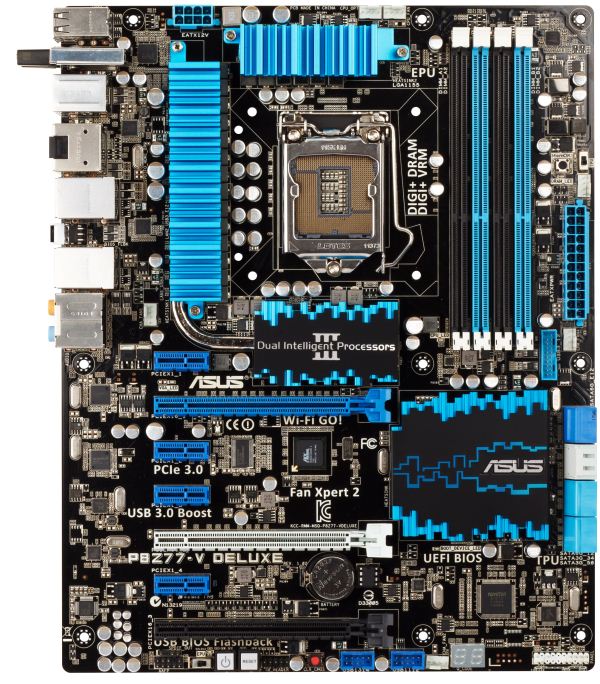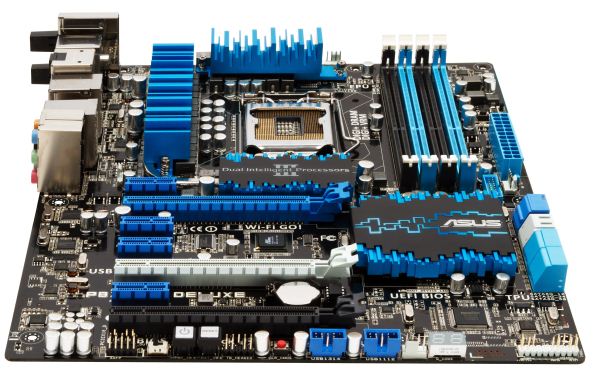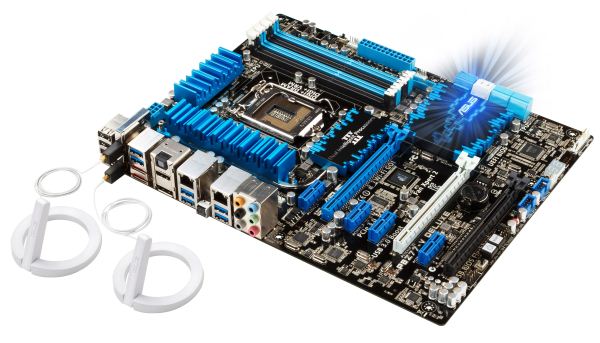Intel Z77 Panther Point Chipset and Motherboard Preview – ASRock, ASUS, Gigabyte, MSI, ECS and Biostar
by Ian Cutress on April 8, 2012 12:00 AM EST- Posted in
- Motherboards
- Intel
- Biostar
- MSI
- Gigabyte
- ASRock
- Asus
- Ivy Bridge
- ECS
- Z77
ASUS P8Z77-V Deluxe—Visual Inspection
In the next notch up in the channel board segregation, ASUS sell the Deluxe. This will be the first ASUS Deluxe board we have reviewed at AnandTech since the Llano mini-ITX F1A75-I Deluxe last year. In comparison to the P8Z77-V Pro, the Deluxe features several upgrades in terms of functionality and comfort.
The first to note is the increased power delivery to the CPU—this time in the form of a 16 + 4 phase power delivery. As a result, the VRM heatsinks to the left of the CPU are directly connected via a heatpipe to another heatsink below the socket. Also on board are the ‘enthusiast’ power/reset buttons and two-digit debug that we did not see on the Pro, and the use of dual NICs on the I/O, in the form of an Intel 82579V and a Realtek 8111F.
Due to the positioning off the heatsinks on the Deluxe compared to the Pro, the socket area seems a bit smaller (for example, the left hand heatsink is moved further in towards the socket), meaning that big air coolers may have a tougher time if they do not fit into Intel’s socket specification. Around the socket itself, we still have access to five fan headers—two 4-pin on the top of the board, one 4-pin to the bottom left of the main VRM heatsink, and one 4-pin either side of the 24-pin ATX power connector. A sixth fan header on board is found at the bottom next to the two-digit debug output.
Above the main power connector on the right hand side are the MemOK button and the TPU switch (for a fast automatic overclock). Below it is a USB 3.0 header, and a set of eight SATA ports. Similar to the ASUS Pro, we have four SATA 3 Gbps from the PCH, two SATA 6 Gbps also from the PCH, and two SATA 3 Gbps from a different controller—the Marvell 9128. This allows RAID 0/1 on these two SATA 6 Gbps ports.
The south side of the board still contains front panel headers and USB 2.0 ports, but also comes with the aforementioned power/reset buttons and two-digit debug display. We also find a ClearCMOS button on board, useful for overclockers. There is also a header labelled 'TB_Header', which should mean Thunderbolt, but there is no mention of it in the specifications. I will have to check up on this.
Update: The TB_Header is actually for a new Thunderbolt add-in card that ASUS will be selling. This is aimed to go into the x4 slot and provide Thunderbolt connectivity. MSRP will be around the $30-$40 mark so I am told.
In terms of the PCIe, we have a little bit of confusion. While in the middle between the PCIe is a PLX chip, it is not the PLX PXE 8747 chip that increases PCIe lane count. The one on the Deluxe is just to provide extra data transfer access for the various controllers on the motherboard. This means that the third full length PCIe in black is like other boards in that this is a PCIe 2.0 x4, non-GPU port. So from the top, we have a PCIe x1, x16 (x8 in Multi-GPU), x1, x1, x8, x1, x4. As a result, there is no PCIe to PCI bridge chip on this high-end model for PCI slots.
For the back panel, ASUS have done a juggling act deciding what to include. On the far left is a set of four USB 2.0 ports (black), a mini-PCIe WiFi + Bluetooth module, two USB 3.0 (blue), two eSATA, optical SPDIF output, HDMI output, DisplayPort, dual gigabit Ethernet, another four USB 3.0 ports (blue), a BIOS flashback button, and audio outputs. So in the name of a double NIC and 10 total USB ports on the back panel, we have lost D-Sub, DVI, IEEE1394 and a ClearCMOS button.
Board Features
| ASUS P8Z77-V Deluxe | |
| Size | ATX |
| CPU Interface | LGA-1155 |
| Chipset | Intel Z77 |
| Power Delivery | 16 + 4 |
| Memory Slots |
Four DDR3 DIMM slots supporting up to 32 GB Up to Dual Channel |
| Video Outputs | DisplayPort, HDMI |
| Onboard LAN |
Intel 82579V Realtek 8111F |
| Onboard Audio | Realtek ALC898 |
| Expansion Slots |
2 x PCIe x16 Gen3 (x16, x8/8) 1 x PCIe x16 Gen2 (x4) 4 x PCIe x1 Gen2 |
| Onboard SATA/RAID |
2 x SATA 6 Gbps (PCH), Support for RAID 0, 1, 5, 10 2 x SATA 6 Gbps (Marvell PCIe 9128), RAID 0, 1 4 x SATA 3 Gbps (PCH), Support for RAID 0, 1, 5, 10 2 x eSATA 6 Gbps (ASMedia) |
| USB |
Four USB 3.0 at rear (2 PCH, 2 ASMedia) Two USB 3.0 headers on board (PCH, ASMedia) Eight USB 2.0 (4 back panel, 4 on board) |
| Onboard |
4 x SATA 6 Gbps 4 x SATA 3 Gbps 1 x USB 3.0 Headers 2 x USB 2.0 Headers 6 x Fan Headers 1 x SPDIF Header 1 x Front Panel Audio Header 1 x TB Header MemOK! Button TPU/EPU Switches USB Flashback Button Power/Reset Buttons |
| Power Connectors |
1 x 24-pin ATX connector 1 x 8-pin 12V connector |
| Fan Headers |
1 x CPU Fan Header (4-pin) 4 x CHA Fan Headers 1 x OPT Fan Header |
| IO Panel |
2 x eSATA 6 Gbps 1 x DisplayPort 1 x HDMI 1.4a 2 x Gigabit Ethernet 6 x USB 3.0 4 x USB 2.0 1 x Optical SPDIF Audio Outputs Bluetooth V4.0 Wifi USB Flashback |
| Warranty Period | 3 Years |
| Product Page | Link |
Obviously one of the main selling points of the board is the onboard WiFi and Intel NIC (alongside a Realtek NIC).














145 Comments
View All Comments
Springf - Sunday, April 8, 2012 - link
Quote: Native USB 3.0The other long awaited addition found on Panther Point is the native implementation of USB 3.0 that comes directly from the chipset. The chipset will only provide two USB 3.0 ports,
------- end quote
I think Z77 natively support 4 USB 3.0 ports
http://www.intel.com/content/dam/www/public/us/en/...
C'DaleRider - Sunday, April 8, 2012 - link
When you write sentences like this:"ASUS have a lot to live up to with its Ivy Bridge Pro board."
You do realize that you're mixing a plural verb and singular pronoun for the same damn thing...Asus in this case. First, you use a plural verb talking about Asus and then use a singular pronoun for Asus in the same sentence. You cannot do both; well, I guess you can, but you show you have no clue about English grammar and look like you dropped out of third grade.
Get a copy editor! How can anyone take this site a professional when the writing borders on illiterate?
sausagestrike - Sunday, April 8, 2012 - link
You should higher a sand removal specialist to take a look at you're twat.Arbie - Monday, April 9, 2012 - link
@C'DaleRider -You do realize that... you're the illiterate one, don't you?
"ASUS have" is perfectly legitimate English, and is in fact what you will hear in England itself. "ASUS" is a company of people and can be taken as singular or plural.
For me, the AT editors just made major points right in this set of comments by correcting another ignoramus, who was misusing "begs the question".
Now, can we get back to fan headers?
Iketh - Tuesday, April 10, 2012 - link
no, there are errors STILL all over the place in this article... it's horrid... when your site is 99% words, please make them as easy as possible to comprehend...PLEASE LEARN TO WRITE LIKE ANAND, THX!
Anand, for the love of god, pay a little more to hire a little more education (SEE WHAT I DID THAR??)
nz_nails - Monday, April 9, 2012 - link
"Biostar have unfortunately put much effort in here, with only three to play with..."Should be a "not" in there I suppose.
s1lencerman - Monday, April 9, 2012 - link
I do not understand why non express PCI slots are still on boards. The only one to see the light is MSI, and if they had a bit better performance I would switch from ASUS for my next mobo in a heartbeat. Also, why do these boards have a VGA connector (D-sub)? Intel HD graphics can only support 2 displays max, and if you have more than you should get a dedicated graphics card anyway, and probably already have. I don't see the point.Another thing, when will OEMs start putting the USB hub at the bottom of the board facing down and not away from the board. If you have multiple cards on the board then you can get really cramped really fast when you are trying to use those.
I'm sorely tempted to just wait another year or so till there is a board with these features and over 50% SATA 6G/s, but we'll see if that even comes out in that short of time.
DanNeely - Monday, April 9, 2012 - link
1) Some customers are asking for them. Customer demand was why a few boards started sporting floppy controllers again last summer. Legacy PCI demand is almost certainly much higher.2) Intel doesn't have enough PCIe lanes on the southbridge for well featured ATX boards.
2.1) This means a bridge chip of some sort.
2.2) PCIe devices are used to being able to count on the full 250/500MBps bandwidth.
2.3) Legacy PCI devices are used to sharing their bandwidth (133MBps).
2.4) 2.2 and 2.3 combined mean there's less risk of compatibility problems in filling out a few slots with legacy PCI slots.
This is probably going to remain an issue until either:
A) Intel increases the number of lanes they offer on their boards by a half dozen or so (bridges are also used for on board devices).
B) Intel integrates a lot more stuff into the southbridge so it doesn't need PCIe lanes: More USB3, Sata6GB, audio, ethernet.
C) A new version of PCIe allows sizes other than powers of two. Fitting everything on would be much easier if a board maker could fall back on just offering 13/1x or 7/7x on the main gfx slots.
jfelano - Monday, April 9, 2012 - link
GReat to see Asrock finally stepping up with the warranty, great products.James5mith - Monday, April 9, 2012 - link
Something I realized by reading this roundup:Almost all of the current motherboards are using PCI connected Firewire chips. Even the ones that have PCIe connected firewire use TI chips, which in turn are still PCI firewire, with an internal PCI to PCIe translator.
After some research the only native PCIe firewire controller I've found is from LSI. Does anyone else know of another solution? This is an interesting "dirty secret" that I never really paid any attention to.